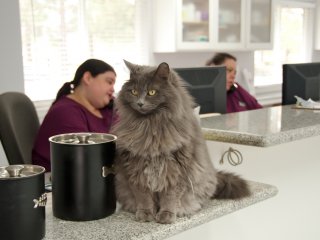
- Description
- Objectives
- Outline
- Materials
- System Requirements
- Watch a Demo
This amazing new program is for all animal lovers. Whether you are looking to start a pet grooming business or want to learn to take care of your own furry family memebers, this program is for you. You will start by learning the correct medical terminology for animals which will allow you to understand animals anatomy, physiology, and how to best care for pets.
Veterinary Medical Terminology
Veterinary Medical Terminology provides a visual approach to learning medical terms and understanding the basics of veterinary medicine. A systematic process of breaking down medical terms into their component parts allows readers to comprehend the root medical concepts and apply critical thinking skills when faced with new and unfamiliar medical terminology. Case studies exemplify how medical terminology would be experienced in an actual veterinary practice.
The software provided with this course makes review of the concepts fun through the use of interactive games and audio pronunciation of the terms.
Prerequisite(s): None
First Aid for Dogs and Cats
When your dog or cat is injured or sick, accurate assessment of the situation and quick treatment is vital to recovery. It is important to be prepared for even the most common injuries and have the necessary supplies available at all times. Our First Aid for Dogs and Cats course provides a comprehensive guide to keep your pet healthy. This course covers medications, proper dosages, common illnesses and injuries, such as burns, breathing problems, wound care and much more.
Start Your Own Home-Based Pet Grooming Business
Are you an animal person? Do you consider your pet a part of your family? The number of pet-owning households is growing every year. The grooming industry is booming. At last count, there were around 60,000 to 80,000 pet groomers in the U.S. Our Start Your Own Home-Based Pet Grooming Business course lays the framework for developing your own pet grooming business. We cover pet services that are in demand, training you need to become a pet groomer, and business basics – finances, insurance, marketing, and business branding. This course will teach you all the steps necessary for creating a successful home-based pet grooming business.
DIY Dog Grooming
There are many reasons regularly grooming your dog is important. A few are changing climates, avoiding stinky, matted hair, and flea and tick control. Our DIY Dog Grooming course will explain the proper steps for professionally grooming your pets – all from the comfort of your home. You’ll be introduced to a number of grooming tools, techniques for bathing and trimming, and cleaning up after common problems, such as dirt and paint. We’ll also discuss how to use items from your pantry – such as essential oils and making your own dry shampoo and leave-in conditioners. This course will help improve your dog’s quality of life by showing you safe, effective, and proper grooming techniques you can easily do from home on your schedule.
** Course Subject to Change.
Veterinary Medical Terminology
At the completion of this course you should be able to:
- Identify the core elements of veterinary medical terminology
- List the steps to analyze prefixes and suffixes
- Define the function and structure of systems of the body
- Recall common anatomical terminology for various animals
- Recognize terms to describe procedures performed on various systems of the body to treat injury and disease
First Aid for Dogs and Cats
After completing this course, you should be able to:
- Recall how to build a proper first aid kit for your pet and essential items for a kit
- Identify common injuries and how to specifically treat each one
- Recognize how to treat basic illnesses and injuries at home
- Name the different health conditions and how to treat them using a first aid kit
Start Your Own Home-Based Pet Grooming Business
After completing this course, you should be able to:
- Identify methods for becoming a pet groomer, such as training and creating a business plan
- Recall the basics of developing your home-based business, such as accounting and obtaining insurance
- Recognize the steps for constructing your home grooming shop
- Discuss how to market and advertise your pet grooming business to increase business growth opportunities
DIY Dog Grooming
After completing this course, you should be able to:
- Recall ways for identifying your dog’s coat and ear types for proper grooming
- Identify common tools and techniques for grooming and brushing - including clippers, shears, and handling mats
- Recognize proper ways for bathing your dog, trimming nails and hair, and common solutions for grooming problems
- Discuss household items that can be made to groom your dog - including essential oils, dry shampoo, and conditioners
Veterinary Medical Terminology
Veterinary Medical Terminology Module 1
Introduction to Medical Terminology
- Anatomy of a Medical Term
- Prefixes & Suffixes
- Combining Vowels & Forms
- Analyzing Medical Terms
- General Pronunciation Guidelines
- Positions & Planes
- Grouping Things Together
- Labeling a Diagram
- The Skeletal System
- The Muscular System
Veterinary Medical Terminology Module 2
Common Anatomical Terms
- Two Words, Same Meaning
- Common Anatomical Terms for Equine
- Common Anatomical Terms for Cattle
- Common Anatomical Terms for Goats
- Common Anatomical Terms for Sheep
- Common Anatomical Terms for Swine
- Common Anatomical Terms for Dogs
- Common Anatomical Terms for Cats
- The Digestive System
- The Urinary System
Veterinary Medical Terminology Module 3
Body Systems - Part 1
- Function of the Cardiovascular System
- Structure of the Cardiovascular System
- Pathology & Procedures of the Cardiovascular System
- Function & Structure of the Respiratory System
- Pathology & Procedures of the Respiratory System
- Function & Structure of the Integumentary System
- Pathology & Procedures of the Integumentary System
- Function & Structure of the Endocrine System
- Pathology of the Endocrine System
- Procedures of the Endocrine System
Veterinary Medical Terminology Module 4
Body Systems - Part 2
- The Reproductive System
- The Estrous Cycle
- Mating, Pregnancy, and Birth
- The Nervous System
- Central Nervous System
- Peripheral Nervous System
- Function & Structure of the Eye
- Mechanism of Hearing
- Mechanism of Equilibrium
- Pathology & Procedures of the Ears
Veterinary Medical Terminology Module 5
Systems & Diseases
- The Hematologic System
- The Lymphatic System
- The Immune System
- Oncology
- Laboratory Terminology
- Pathogenic Organisms
- Types of Diseases
- Endoscopy
- Imaging Techniques
- Pharmacologic and Surgical Terms
Veterinary Medical Terminology Module 6
Dealing with Specific Animals
- Anatomy, Breeding, & Vaccinations
- Dogs & Cats
- Descriptive Terms
- Horses, Donkeys, Mules, and Ponies
- Terms for Unsoundness in Horses
- Ruminants: Cattle, Sheep, Goats, and Camelids
- Pigs and Swine Management Terms
- Birds, Poultry, and Pet Bird Terms
- Rodents, Ferrets, and Rabbits
- Reptiles and Amphibians
**Outlines are subject to change, as courses and materials are updated.**
First Aid for Dogs and Cats
First Aid for Dogs and Cats Module 1 Part 1 First Steps in First Aid
Basics of First Aid
Module one discusses how to build a proper first aid kit for your pet. We will discuss the essential supplies you need to treat your pet in case of basic injuries or illnesses, such as bandages, tweezers, thermometer and medicines like antihistamines and pain relievers. Dosage directions for medications, proper restraint techniques and tips for taking your pet’s temperature are covered, as well as ideas for pet proofing your home to keep your animal safe.
- Essential Medicine Chest
- Basic First Aid Techniques
- Preventing Heath Problems
- First-Aid Symptom Finder
- Assessing Health Issues
First Aid for Dogs and Cats Module 2 Part 2 – Abdominal Wounds to Drowning
Common Injuries and Conditions
Module two illustrates what to use in a first aid kit to treat specific injuries and conditions, such as wounds, burns, allergies, bleeding, bowel obstructions, choking, constipation, and dehydration. We cover step by step instructions for treating these issues at home. Also we will discuss follow up treatments and preventive care.
- Airborne Allergies
- Burns
- Choking and Collapsing
- Bleeding
- Cuts, Wounds and Bleeding
First Aid for Dogs and Cats Module 3 Part 2 Earflap Injuries to Kneecap Slipping
Basic Illnesses
Module three covers the tools to use in a first aid kit for specific injuries and illnesses, such as fever, falls, food allergies, foreign objects in ear, eye, mouth, fleas, head injuries and swelling, heatstroke, hives, jaw problems, and kneecap slipping. We cover step by step instructions for treating these issues at home, as well as follow up treatments, preventive care and knowing when to call a veterinarian.
- Foreign Objects in the Body
- Head Injuries and Swelling
- Fractures
- Hypothermia
- Fleas and Bites
First Aid for Dogs and Cats Module 4 Part 2 Leg Swelling to Worms
Health Conditions
Module four identifies the tools to use in a first aid kit for specific injuries and illnesses, such as low blood sugar, nail damage, nosebleeds, paw damage, seizures, shock, skin infections, strangulation, suffocation, tooth issues and worms. We cover step by step instructions for treating these issues at home, as well as follow up treatments, preventive care and knowing when to call a veterinarian.
- Mouth Injuries and Sores
- Skin Infections
- Strangulation and Suffocation
- Tongue and Tooth Damage
- Vomiting
Start Your Own Home-Based Pet Grooming Business
Start Your Own Home-Based Pet Grooming Business Module 1
Why Pet Grooming?
When it comes to pampering their fur babies, pet owners don’t hold back. Different breeds of dogs require different types of grooming. Every breed of dog should visit a professional groomer at least 4 times a year. This module will explore pet services that are in demand today, as well as training needed to become a licensed groomer. We’ll also dive into creating a business plan and choosing the right name for your company.
- Pet Services in Demand Today
- Golden Reputation
- Creating a Business Plan
- Licenses and Permits
- Pet Population
Start Your Own Home-Based Pet Grooming Business Module 2
Business Basics
Becoming a business owner requires a major shift in your mindset. You will always need to focus on the bottom line. This module aims to make the process of becoming a business owner less stressful by helping you be prepared. We will discuss choosing the right accountant, tax responsibilities, and how to properly insure yourself and your business. We’ll also examine how to correctly equip your office.
- Accounting and Taxes
- Your Balance Sheet
- Insuring Your Success
- Business Bank Account
- Equipping Your Office
Start Your Own Home-Based Pet Grooming Business Module 3
Constructing Your Home Grooming Shop
It takes a lot of planning and consideration when deciding to start a home-based pet grooming business. You’ll need to have an adequate amount of room and a welcoming reception area. Your grooming space should be clean and you should have the right tools to do the job. We’ll also examine how to finance your grooming business.
- Room to Grow
- Financing Your Grooming Business
- What Will It Cost?
- Pet Grooming Housekeeping
- Grooming Shows and Competitions
Start Your Own Home-Based Pet Grooming Business Module 4
Marketing and Public Relations
You’ll need to understand how to set your prices, marketing, and advertising before you take the plunge into creating your own pet-grooming business. This module will explore various avenues for marketing – magazines, websites, and social media. We will also cover ways to make your business grow, hiring employees, and keeping staff motivated.
- Setting Your Prices
- Advertising
- The Personal Touch
- Growth Opportunities
- How to Pay Employees
DIY Dog Grooming
DIY Dog Grooming Module 1
Identification and Tools
Nobody will share the same special bond that you do with your dog. Taking the time and effort to learn how to properly groom your pet is important. The first module of this course will help you identify your dog’s type of coat and recommended grooming tips. We’ll also cover anatomy of nails, ears, and paws. Finally, we discuss common grooming tools such as brushes, combs, shears, and nail care.
- Dog Breed
- Hair Type
- Nails and Ears
- Brushes and Combs
- Shears, Clippers, Nail Care
DIY Dog Grooming Module 2
Brushing and Bathing
Brushing is the most important tool for early detection of many health issues. You’ll be able to identify bumps, skin issues, fleas, and ear problems. In this module we’ll examine the de-matting process and how to work with undercoats. We’ll also discuss proper techniques for bathing your dog – shampooing, conditioning, thoroughly rinsing, and how to wash faces and ears.
- Brushing and Mats
- De-Matting
- Undercoats
- Shampooing, Rinsing, Conditioning
- Face, Ears, Teeth
DIY Dog Grooming Module 3
Trimming and Grooming Issues
You should have a clear and planned out idea before beginning the trimming process. In this module, we’ll discuss safe techniques for trimming nails, pads, feed, heads, and faces. We’ll also recognize common problems that your pet might get into such as dirt, paint, grease, skunk smells, fleas, ticks, and how you should treat burns and injuries.
- Trimming Nails
- Trimming Pads, Feet, Heads, Faces
- Grease, Dirt, Mud
- Paint, Wax, Superglue
- Skunk, Fleas, Ticks, First Aid
DIY Dog Grooming Module 4
Accessories and Grooming Solutions
This module will provide tips and tricks for taking the perfect picture of your pooch. We’ll discuss dramatic haircuts and keeping hair in place to snap the perfect photo. We’ll also cover grooming solutions that you can make at home – such as making dry shampoo, leave-in conditioners, paw cleaners, and ear cleaners.
- Dramatic Haircuts
- Essential Oils
- Dry Shampoo & Leave-in Conditioners
- Paw Care
- Ear Cleaner
Ed4Career is committed to being both environmentally conscious and making it easier for you to study! We’re making your education mobile! All of our textbooks are now provided as eTextbooks*. You can access them on your laptop, tablet, or mobile device and can study anytime, anywhere.
The move away from physical books to eTextbooks means you get the latest, most up-to-date version available. This also makes your training more accessible, so you can study anywhere you have your phone or tablet. The best part is that all materials are included in your training cost so there are NO extra fees for books!**
*A few courses still have physical materials.
Internet Connection
- Broadband or High-Speed - DSL, Cable, and Wireless Connections
*Dial-Up internet connections will result in a diminished online experience. Classroom pages may load slowly and viewing large audio and video files may not be possible.
Hardware Requirements
- Processor - 2GHz Processor or Higher
- Memory - 1 GB RAM Minimum Recommended
PC Software Requirements
- Operating Systems - Windows 7 or higher
- Microsoft Office 2013 or higher. Also, you could use a general Word Processing application to save and open Microsoft Office formats (.doc, .docx, .xls, .xlsx, .ppt, .pptx)
- Internet Browsers - Google Chrome is highly recommended
- Cookies MUST be enabled
- Pop-ups MUST be allowed (Pop-up Blocker disabled)
- The Kindle Reader App or VitalSource Bookshelf App are needed for many of our courses (No special equipment needed. This can be downloaded for FREE onto your computer.)
- PowerPoint Viewer (if you do not have PowerPoint)
- Adobe PDF Reader
- QuickTime, Windows Media Player &/or Real Player
MAC Software Requirements
- Operating Systems - Mac OS x 10 or higher with Windows
- Mac office programs or a Word Processing application to save and open Microsoft Office formats (.doc, .docx, .xls, .xlsx, .ppt, .pptx)
- Internet Browsers- Google Chrome is highly recommended
- Cookies MUST be enabled
- Pop-ups MUST be allowed (Pop-up Blocker disabled)
- The Kindle Reader App or VitalSource Bookshelf App are needed for many of our courses (No special equipment needed. This can be downloaded for FREE onto your computer.)
- PowerPoint Viewer (if you do not have PowerPoint)
- Adobe PDF Reader
- Apple QuickTime Media Player


